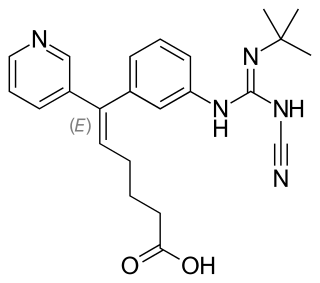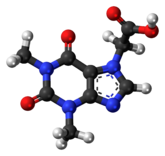
Benzatropine (INN), known as benztropine in the United States and Japan, is a medication used to treat movement disorders like parkinsonism and dystonia, as well as extrapyramidal side effects of antipsychotics, including akathisia. It is not useful for tardive dyskinesia. It is taken by mouth or by injection into a vein or muscle. Benefits are seen within two hours and last for up to ten hours.
An international nonproprietary name (INN) is an official generic and nonproprietary name given to a pharmaceutical drug or an active ingredient. INNs are intended to make communication more precise by providing a unique standard name for each active ingredient, to avoid prescribing errors. The INN system has been coordinated by the World Health Organization (WHO) since 1953.
A British Approved Name (BAN) is the official, non-proprietary, or generic name given to a pharmaceutical substance, as defined in the British Pharmacopoeia (BP). The BAN is also the official name used in some countries around the world, because starting in 1953, proposed new names were evaluated by a panel of experts from WHO in conjunction with the BP commission to ensure naming consistency worldwide (an effort leading to the International Nonproprietary Name system). There is also a British Approved Name (Modified) (BANM).
The nomenclature of monoclonal antibodies is a naming scheme for assigning generic, or nonproprietary, names to monoclonal antibodies. An antibody is a protein that is produced in B cells and used by the immune system of humans and other vertebrate animals to identify a specific foreign object like a bacterium or a virus. Monoclonal antibodies are those that were produced in identical cells, often artificially, and so share the same target object. They have a wide range of applications including medical uses.

Mertansine, also called DM1, is a thiol-containing maytansinoid that for therapeutic purposes is attached to a monoclonal antibody through reaction of the thiol group with a linker structure to create an antibody-drug conjugate (ADC).

Terbogrel (INN) is an experimental drug that has been studied for its potential to prevent the vasoconstricting and platelet-aggregating action of thromboxanes. Terbogrel is an orally available thromboxane A2 receptor antagonist and a thromboxane A synthase inhibitor. The drug was developed by Boehringer Ingelheim.

Cenicriviroc is an experimental drug candidate for the treatment of HIV infection and in combination with Tropifexor for non-alcoholic steatohepatitis. It is being developed by Takeda and Tobira Therapeutics.
Milacemide (INN) is an MAO-B inhibitor and glycine prodrug. It has been studied for its effects on human memory and as a potential treatment for the symptoms of Alzheimer's disease. Early clinical trials did not show positive results however, and the drug is now abandoned and it is sold as a nonprescription drug or supplement. While milacemide is not an amino-acid, it acts similarly to glycine in the brain.
Drug nomenclature is the systematic naming of drugs, especially pharmaceutical drugs. In the majority of circumstances, drugs have 3 types of names: chemical names, the most important of which is the IUPAC name; generic or nonproprietary names, the most important of which are international nonproprietary names (INNs); and trade names, which are brand names. Under the INN system, generic names for drugs are constructed out of affixes and stems that classify the drugs into useful categories while keeping related names distinguishable. A marketed drug might also have a company code or compound code.
Imgatuzumab (INN) is a humanized monoclonal antibody designed for the treatment of cancer. It is an anti-EGFR antibody that acts as an immunomodulator.

Tofogliflozin is an experimental drug for the treatment of diabetes mellitus and is being developed by Chugai Pharma in collaboration with Kowa and Sanofi. It is an inhibitor of subtype 2 sodium-glucose transport protein (SGLT2), which is responsible for at least 90% of the glucose reabsorption in the kidney. As of September 2012, the drug is in Phase III clinical trials.
Bococizumab is a drug that was in development by Pfizer targeting PCSK9 to reduce LDL cholesterol. Pfizer withdrew the drug from development in November 2016, determining that it was "not likely to provide value to patients, physicians or shareholders."
Odalasvir is an investigational new drug in development for the treatment of hepatitis C. It is an NS5A inhibitor. The NS5A protein serves multiple functions at various stages of the viral life cycle, including viral replication. NS5A also plays a role in the development of interferon-resistance, a common cause of treatment failure. It is under development by Achillion Pharmaceuticals.

Encenicline is a selective partial agonist of the α7 nicotinic receptor. It was in phase III clinical trials for the treatment of cognitive impairment in schizophrenia, but failed to meet the study endpoints in 2016.

Carmoterol is a non-catechol experimental ultra-long-acting β adrenoreceptor agonist (ultra-LABA) that was in clinical trials before 2010 when it has been withdrawn from further development based on evidence that the compound does not possess a competitive profile.

Oprozomib is an orally active second-generation proteasome inhibitor developed by Proteolix, which was acquired by Onyx Pharmaceuticals, an Amgen subsidiary, in 2009. It selectively inhibits chymotrypsin-like activity of both the constitutive proteasome (PSMB5) and immunoproteasome (LMP7).

Vaborbactam (INN) is a non-β-lactam β-lactamase inhibitor discovered by Rempex Pharmaceuticals, a subsidiary of The Medicines Company. While not effective as an antibiotic by itself, it restores potency to existing antibiotics by inhibiting the β-lactamase enzymes that would otherwise degrade them. When combined with an appropriate antibiotic it can be used for the treatment of gram-negative bacterial infections.

Danoprevir (INN) is an orally available 15-membered macrocyclic peptidomimetic inhibitor of NS3/4A HCV protease. It contains acylsulfonamide, fluoroisoindole and tert-butyl carbamate moieties. Danoprevir is a clinical candidate based on its favorable potency profile against multiple HCV genotypes 1–6 and key mutants (GT1b, IC50 = 0.2–0.4 nM; replicon GT1b, EC50 = 1.6 nM). Danoprevir has been evaluated in an open-label, single arm clinical trial in combination with ritonavir for treating COVID-19 and favourably compared to lopinavir/ritonavir in a second trial.











